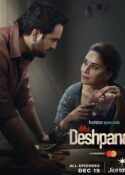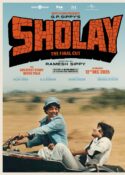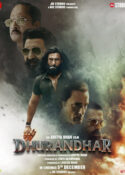 Once I asked the inimitable unforgettable Dev Anand what his birthday wish was… His response was typical DA: “I don’t make wishes. I make them come true. I go with exactly what I want to do. It’s an ongoing process. As long as I feel creative and as long as I feel there are some people who want to watch my films I’ll continue to make them. If I’m not as enthusiastic about my new film then I’ve no business making it. The very fact that I’ve picked up the responsibility of directing another film proves I’ve the energy for it. The day I don’t, I won’t make any more films. My audience, my fans are my source of energy. I need my fans’ good wishes gives me my energy?”
Once I asked the inimitable unforgettable Dev Anand what his birthday wish was… His response was typical DA: “I don’t make wishes. I make them come true. I go with exactly what I want to do. It’s an ongoing process. As long as I feel creative and as long as I feel there are some people who want to watch my films I’ll continue to make them. If I’m not as enthusiastic about my new film then I’ve no business making it. The very fact that I’ve picked up the responsibility of directing another film proves I’ve the energy for it. The day I don’t, I won’t make any more films. My audience, my fans are my source of energy. I need my fans’ good wishes gives me my energy?”
And how does he define Dev Anand? Without a thought he replied, “If you want to define Dev Anand, it would be to be as ‘restlessness’. While I am making a film I am totally consumed by it. But yes, a part of my mind moves to the next project.I am a born explorer. Cinema is only a chosen medium for my exploration. It is an excuse to make new friends and pursue new dreams. Some very beautiful women have been part of my journey. From Suraiya to Madhubala to Waheeda Rehman to Zeenat Aman to Hema Malini to Raakhee…every actress and actor I have worked with has made a difference to my life. Every technician who has contributed to my cinema is a star. Every film I directed may not have been a Guide or Johnny Mera Naam. But even the failures have made a difference to my life.”
After all these years it is still difficult to believe Dev Anand is not with us. Dev Anand was at a peak all his life where everything and everyone seemed a speck. So many memories and so much of the life-force squeezed into one large microscopic view of the entire universe that it became impossible to tell the dancer apart from the dance.
When he died it was a shock because….well, some things are never meant to end. He was undoubtedly the youngest actor I knew in Bollywood. His spirit was indefatigable. And he was the most easygoing superstar cinema one has ever known.
Repetition was death to Dev Saab. In his typically exuberant way he once told me, “It is such an exhilarating experience to let the creative process flow through you. When you are falling back on a remake or remix how are you being creative? I’d never do a remake. All my films are original. Man moves on physically and emotionally. When you remake a film how are you doing it justice or even guaranteeing its success? The audience that saw the original is not the same that will see the remake. A remake is an easy way out.Instead of tapping your own creativity you simply tap into another person’s creativity. How can you think of doing something that’s been done already? I can never do it. Today people remember my ‘Guide’ and ‘Hare Rama Hare Krishna’ as vividly as they did when it was made. So why remake them? I’d never remake Hollywood films either. They are filled with gimmicks these days. Go back to the grand Hollywood era of the 1950s of the great makers and stars….where are they now?”
Raakhee Gulzar could never say no to him. She is one of Dev Anand’s biggest fans. Not just her, but her entire family—her late mom and dad included—were huge Dev Anand fans. Unquestioningly, this otherwise-fastidious actress said yes to anything he offered her. And the same goes for every actor he approached, from Rekha who starred in the tour de ‘farce’ Censor (playing the censor chief, inspired by Asha Parekh who headed the censor board back then) to Salman Khan who took up a guitar and strummed away on stage in Love At Times Square because… well… Dev Saab asked him to.
Perhaps the fact that Dev Anand symbolized the most dazzling bastion of Hindi cinema had something to do with our collective caution about his feelings. It didn’t matter if this man… no, this institution ….no longer functioned creatively or even coherently in his last 15 years. What mattered was he was the guy who made the nation swoon by wooing Nutan in Tere Ghar Ke Samne, Waheeda Rehman in Guide and Hema Malini in Johnny Mera Naam.
Flamboyant, debonair, mischievous and romantic, Dev Anand’s personality is best manifested in the song he sang in Hum Don: Main zindagi ka saath nibhata chala gaya; har fiqr ko dhuen mein udata chala gaya….
Hema Malini’s mother was a huge fan of Dev Anand, so she grew up hearing his name and watching his films. Her career’s second film Johnny Mera Naam was with Dev Anand . Hema was so young and Dev was a huge star. But he never made her feel like a newcomer. They shot the film’s cable-car sequence for the song Wada to nibhaya at Rajgir in Bihar. The crowds got unwieldy. Dev Anand looked after her.
Dev Anand was always on the move. He was genetically restless, and he didn’t appreciate people around him who couldn’t keep pace with him. Watching him at work was like taking a vitamin tablet.
Asha Parekh compares working with Dev Anand to being on an express train. The journey was relentless and exhilarating.
Dev Anand was such a huge star that people didn’t give him enough credit as an actor. He was very stylish. But he was also a brilliant actor. His clothes, hairstyle, the way he talked and waked exuded glamour and uniqueness. And he was a complete film person. Actor, director, writer, producer….He lived breathed ate and slept cinema. Dev Saab’s enthusiasm infected everyone he worked with.
Among his neglected performances we could count Rahi. Based on litterateur Mulk Raj Anand’s story ‘The Wayfarer’ the film about the relationship between British colonists and Indians was shot in a neo-realistic light by progressive intellectual director K A Abbas. Very seldom did Dev Anand step into the territory of the unwaveringly experimental cinema. He did so in Rahi. The film was internationally celebrated .Dev Saab and his leading lady Nalini Jaywant went to Russia with the film. It blew the Soviets’ minds.
In Jewel Thief(1967) Dev Anand played his own character’s double who didn’t exist. To find out just how that worked you had to go through a goldmine of gorgeous girls Vyjanthimala, Tanuja, Helen,Fariyal… and terrific songs climaxed by the breathless Hothon pe aisi baat where Dev Anand generously allowed his leading lady to take center stage.
In Paying Guest (1957) Nutan and Dev Anand were fantastic together. They did two lovely rom-coms. I prefer Subodh Mukherjee’s Paying Guest to Vijay Anand’s Tere Ghar Ke Samne. Both the wonderful stars were younger and looked so much in love under the fake studio moon.
In Kala Pani(1958) Dev Anand as man out to prove his jailed father’s innocence exuded so much intense determination that you wondered where and how he found those gaps in his mission to romance the very lovely Madhubala and Nalini Jaywant. Raj Khosla’s new best how to tap Dev Anand’s arrogant romanticism.
Bambai Ka Babu(1960) is an absolute knockout of a movie in Dev Anand’s oeuvre directed by the very gifted Raj Khosla. Khosla directed Dev Anand in a number of films from CID in 1956 to Shareef Badmash in 1973. Bambai Ka Babu portrayed a subtly incestuous relationship. Dev Saab played a fugitive on the run who pretends to be the son of a rich wealthy couple and falls in love with the daughter(Suchitra Sen). In the end Dev Anand had to send off the woman he loves to her sasural as his sister ! The song Chal ri sajni still echoes on our hearts.
Hum Dono (1961) was a dramatic film about look-alikes who were not twins (and that was unusual) who swap lives . The film saw Dev Anand don a double role with much gusto. Yup, the moustache helped. But Dev Anand remained Dev Anand no matter what he played.And he seldom used disguises.He hated fake beards and moustaches. His pairing in Hum Dono with Sadhana seemed blessed by divinity. Hard to say whom Dev Anand paired the best with Sadhana, Nutan, Waheeda Rehman, Raakhee or Hema Malini.
In Tere Mere Sapne(1971), a year after the classic kitschy tale in Johnny Mera Naam Vijay Anand directed his star-brother in a sensitive film about a doctor’s descent from nobility to corruption Mumtaz (who stepped in at the last minute to replace Sharmila Tagore) revealed herself to be one our finest dramatic actresses. The film is suffused with the sounds of sorrow and romance, regret and nostalgia. Its failure broke Dev Anand’s heart.Mumtaz considers it her best film ever. Working with Dev Anand for the first time was a dream come true for her.
It was Mumtaz again in Hare Rama Hare Krishna(1971).By far Dev’s best directorial film,this was a charming tender story of siblings separated by squabbling parents(Kishore Sahu and Achala Sachdev). Shot in Kathmandu, the film has an aura of mystery and tragedy surrounding the plot and characters. Dev and Zeenat were perfect as siblings, so perfect that all subsequent attempts to cast them as romantic leads collapsed.
Guide(1965) is the film that defines Dev Anand’s career. Raju the Guide who guides Rosy’s career into stardom and falls deep into the morass of corruption and damnation came alive as real character, blemishes and all. This is the one film that would keep Dev Anand alive in cinema forever.
Vyjanthimala who did the iconic Jewel Thief with Dev Saab called herself the female Dev Anand. She remembers Dev for being tall. She needed a tall hero. During her time she was supposed to be a tall heroine and she really craved to work with a hero who could be well-matched with her. Dev came along at the right time in her career. Their pairing is remembered to this day for Jewel Thief. Vyjayanthimala remembers sharing some very good times with Dev and his brother Goldie during Jewel Thief. They shot in the outdoors of Gangtok. Then there was that iconic song and dance Hothon pe aisi baat which required inhuman amounts of stamina and energy from her . She thinks the fact that she was working with Dev gave her that energy and stamina.
Recalls Vyjayanthimala, “I remember after we finished shooting this song, Dev clapped. He was a very generous co-star. And a very stylish man. He was very particular about camera angles and wanted to be captured in the best possible way on screen. He took great care over his appearance. I think he defined celluloid heroism.”
The ethereal Waheeda Rehman almost didn’t do her most iconic film Guide. Initially the director was Raj Khosla whom Waheeda didn’t want to work with. Dev tried to convince her. Waheeda wanted Dev’s brother Goldie (Vijay Anand) wasn’t directing. They needed a dancer. Eventually Goldie directed Guide. That’s how she got Guide. Waheedaji did seven films with Dev Anand. In fact her very first film in Hindi CID was with Dev Anand. On the very first day on the set when she called him ‘Dev Saab’ he turned around and said, ‘No no, call me Dev’. She couldn’t bring herself to call him by his first name. The next day when she called him ‘Dev Saab’ he looked around as though he didn’t know whom she was addressing. She had to finally call him ‘Dev’. And ‘Dev’ he remained until the end.When Dev turned director with Prem Pujari Waheeda was in the film, of course.
Waheeda does point out the deterioration in Dev Anand’s creative faculties. “Without meaning any disrespect to him I’d like to say that as the years went by Dev’s script sense went more and more haywire. I think he got too involved with himself. Dev was a very good producer. But he needed to look out for better scripts.”
Perhaps the leading lady Dev Saab was closest to was Zeenat Aman. They worked very closely together and shared much more than a professional relationship. She was on the way out of the country with her mother to join her stepfather in Germany when she got that call from Dev Saab’s office to do Hare Rama Hare Hare Krishna. Technically that wasn’t Zeenat’s first film.
It wasn’t as though the role fell into Zeenat’s lap. She got to play Janice in Hare Rama Hare Krishna by default. Not too many established actresses wanted to play Dev Saab’s sister, especially when Mumtaz had already been signed to play the romantic lead. Tanuja had almost been finalized, and then she opted out. That’s where Zeenat came in.
Zeenat and Dev Anand went to do a series of films through the 1970s. But the transition from playing siblings in Hare Rama Hare Krishna to the romantic lead was gradual and smooth. In their next film together Heera Panna Dev Anand’s romantic lead was Raakhee. Throughout the film his heart went out to her while Zeenat remained the other woman. In their next film together Ishq Ishq Ishq Dev and Zeenat played the proper kosher romantic lead. It bombed.
Dev Anand believed completely in what he did. And he didn’t just talk. He actually put his money where his mouth was. He made his films with complete conviction. He was never afraid to fail. I once asked Dev Saab who was his favourite discovery and he promptly replied, “It’s very difficult to say. There’s something in the personality, face and carriage that hold my attention in a newcomer.”
It couldn’t be easy being Dev Anand… not when you are a one-man army with no backup. Whether it was a film set or his living room I think Dev Saab was a complete loner. But he wasn’t lonely. He liked to be on his own. Every waking hour he was either reading, thinking or planning a film.Right till the end.
He once told me, “I am a loner. But I am not lonely. I live in a world of my own. My world is inside me. I feel a great creative freedom.”
And yes, he had a message for all his fans. “I love my fans and seek their good wishes all the time. The younger generation is so clued in, so huge in mind and impact. As they connect with me, I feel my batteries being recharged. Some of the most remarkable minds of the world stay in our country. And I give them my love and good wishes, continue to see my films.”
We do, Dev Saab, we do. We watch Guide at least once a year. And we instantly forgive you for Love At Times Square.









